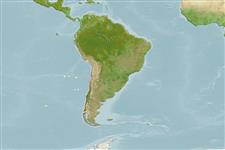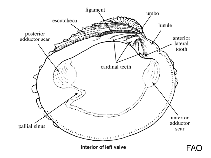Leukoma thaca (Molina, 1782)
Taca clam| Native range | All suitable habitat | Point map | Year 2050 |

|
| This map was computer-generated and has not yet been reviewed. |
| Leukoma thaca AquaMaps Data sources: GBIF OBIS |
Google image | No image available for this species;
drawing shows typical species in Veneridae.
Classification / Names Populärnamn | synonymer | CoL | ITIS | WoRMS
Bivalvia | Venerida | Veneridae
Environment: milieu / climate zone / djupintervall / distribution range Ekologi
; djupintervall 0 - 20 m (Ref. 101272). Temperate, preferred 18°C (Ref. 107945); 16°S - 47°S, 110°W - 70°W
Distribution Länder | FAO områden | Ekosystem | Förekomster | Utplanteringar
Southeast Pacific: Chile, Easter Island, and Peru. Subtropical to temperate.
Length at first maturity / Size / Weight / Age
Könsmognad: Lm ? range ? - ? cm Max length : 8.0 cm SHL hane/ej könsbestämd; (Ref. 101426)
Life cycle and mating behavior Könsmognad | Reproduktion | Lek | Eggs | Fecundity | Larvae
Main reference
referenser | Koordinator | Medarbetare
Urban, H.J. and B. Campos 1994 Population dynamics of the bivalves Gari solida, Semele solida and Protothaca thaca from a small bay in Chile at 36° S. Mar. Ecol. Prog. Ser. 115:93-102. (Ref. 75339)
IUCN Red List Status
(Ref. 130435: Version 2025-1)
CITES status (Ref. 108899)
CMS (Ref. 116361)
Threat to humans
Human uses
Fiskeri: kommersiell
FAO - fiskeri: landings, species profile | FishSource | Sea Around Us
Verktyg
Ytterligare information
Max. ages / sizes
Length-weight rel.
Length-length rel.
Length-frequencies
Mass conversion
Abundans
Internet-källor
BHL | BOLD Systems | CISTI | DiscoverLife | FAO(fiskeri: species profile; publication : search) | Fishipedia | GenBank (genome, nucleotide) | GloBI | Gomexsi | Google Books | Google Scholar | Google | PubMed | Tree of Life | Wikipedia (Go, sök) | Zoological Record



